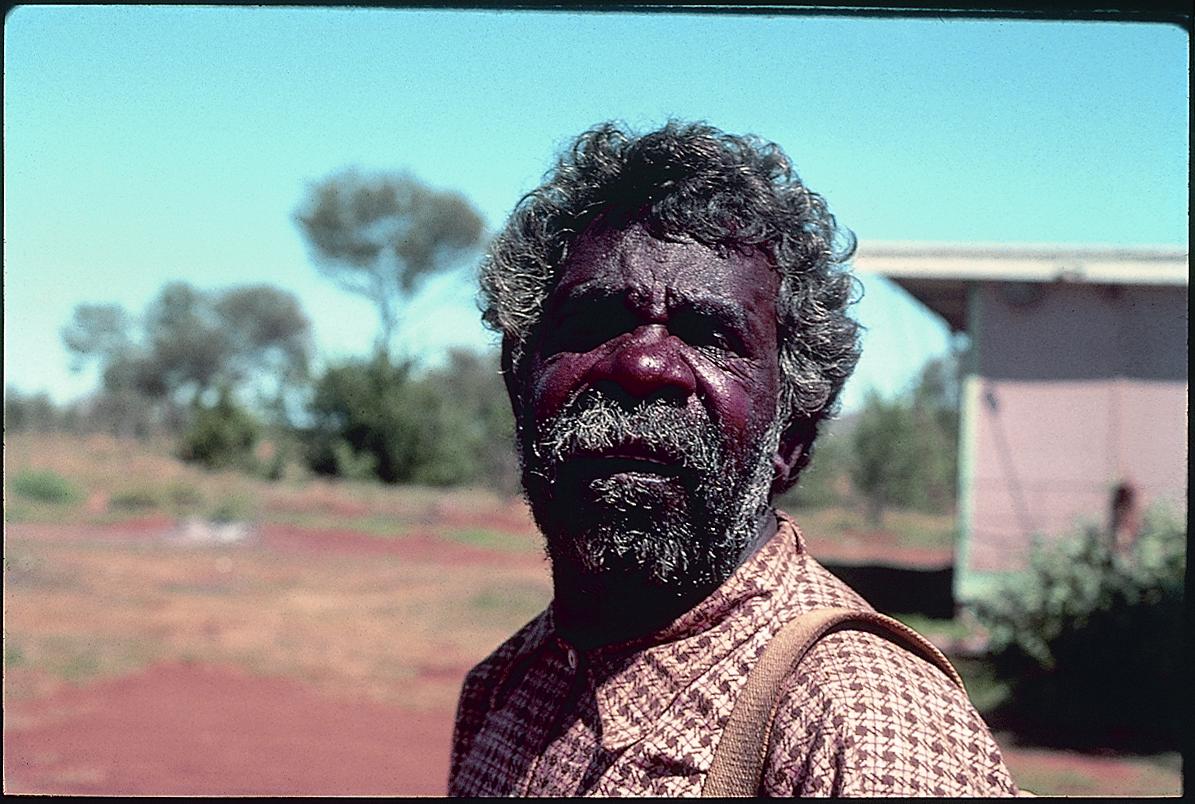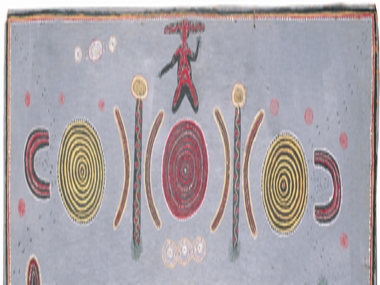ONCE UPON A TIME IN PAPUNYA

Kaapa Mbitjana Tjampitjinpa, Papunya, 1980, photo: Tim Johnson
Jeremy Eccles | 11.11.10
Author: Jeremy Eccles
News source: Book
How to tackle this intimately informed, radically revisionist but ultimately frustrating tale of the art movement that did more than anything to change Australia's views about its indigenous people and bring their culture closer to the cities of the south?
For Prof Vivien Johnson has assiduously pursued the art and artists of Papunya in books, exhibitions and research since 1980 – before almost anyone else was really aware of the power of the possibly 1500 painted boards that had emerged in the years 1971 and 1972 from the distressed settlement that was intended to assimilate Desert tribespeople into a superior white society. This should make the book essential reading. But the Big Picture is limited by the Johnson's version of the story having its origins in two specialised areas of those boards' post-history. And this serves to both diminish its impact and colour its conclusions
In the late 1990s, Tim Klingender at Sotheby's realised the potential of those original boards to give credibility to his newly dedicated Aboriginal art auctions - and fell on his feet with a hidden hoard (as most of the boards were hidden until then) from the family of the artist Tim Guthrie, who'd been in Alice in the early 70s and bought as much of this new art as he could afford. Some he'd never even opened; and one, the about-to-be-enthroned 'Water Dreaming at Kalipinypa' by Johnny Warangkula, he'd stacked behind the washing machine! But when the auctioneer's hammer fell at over $200,000, the painting was immortalised and the Aboriginal art business was off and running seriously.
For Johnson, though, her joy was less in the money that was being made by everyone (other than the original artists), and more in the reappearance of some 700 of the boards that had largely disappeared from view until then. She could now start to categorise them, order them and ultimately analyse them.
Unfortunately, Johnson's new-found expertise lead to her appointment to a government quango – the National Cultural Heritage Committee – one of whose jobs was to decide which of these boards 'mattered' to the country enough to refuse them an export license. For Sotheby's had found a far richer market overseas than in Australia. On this Committee – very unpopular with the auctioneers - Johnson realised that an all-white team was being asked questions it couldn't possibly answer, and spent 6 years to persuade the bureaucrats that the artists themselves, or at least people who were now the contemporary cultural custodians of the art, should be involved in this decision-taking.
But, at the conclusion of this heroic process, Johnson decided that she shouldn't even be looking at the art.
What a tragedy.
For it surely is the very obvious complexity of this art – revealing, as it often did in those earliest of days at Papunya, esoteric elements of secret/sacred ceremonials, combined with a developing aesthetic capacity to speak to a white audience - which belatedly allowed our non-Aboriginal world to peer into the riches of a society that had survived for 40,000 years and had had to develop a rigorous set of laws to achieve that. If you can't even look at this iconic work, what is there?
Of course, this was precisely the row that blew up last year as a consequence of American collector John Wilkerson realising his dream of having his substantial collection of early boards seen and fully considered across the States. Johnson writes about this and her own conflicted involvement in both the catalogue for 'Icons of the Desert' and its presentation. For Wilkerson, she accepts, was not a man who'd 'stolen' Aboriginal culture, but a man who'd fallen in love with a version of Johnny Warangkula's 'Water Dreaming' seen in Darwin and had pursued it honourably. Nevertheless, we, like Johnson were fated not to look at some of his art when the catalogue authors decided to black out nine images from Australian eyes – while Americans were safe to look.
It was a weird decision, and Johnson doesn't explain it. For all the evidence suggests that only uninitiated Aboriginal men and women might be endangered by seeing such secret/sacred material; while the rest of us, in her hero Kaapa Mbitjana's words could “no more learn 'im” - ie understand the harmful information embedded in the boards. What was clear in Australia was the fury of Alison Anderson – the NT's erstwhile Arts and Aboriginal Affairs Minister, grand-daughter of Old Bert Tjakamarra (who Geoffrey Bardon suspects actually gave permission for the painting to start), an artist herself and a former manager of Warumpi Arts in Papunya. For her, the crime of 'Icons' was to publish an often conflicting series of possible meanings for the boards – even the blacked-out ones - by such white worthies as Geoff Bardon and Pat Hogan, the original art dealer in Alice Springs.
“They're just culture vultures”, Anderson told the world, “investigating our sacredness too hard because they're cultureless themselves”! And her views have held sway since in exhibitions involving Donald Thomson's long-unseen Arnhemland barks and in the forthcoming 'Origins' show (of early boards) at the NGV. Both have made a clear point of clearing interpretation rather than imagery with contemporary cultural custodians.
Interestingly, Johnson herself is pretty free with her interpretations in the Art Gallery of SA's 1996 catalogue, Dreamings of the Desert. In the current AGSA catalogue, Desert Country – which I'll be reviewing soon – commentary on the same Kaapa Mbitjana work, Untitled 1971, is treated much more circumspectly by Curator, Nici Cumpston.
Cumpston, though, has clearly not read Johnson's book. For the dating of this Untitled work is a key to Johnson's brave claims that Kaapa was actually painting before the saintly Geoffrey Bardon is supposed to have encouraged the men of Papunya to take up their brushes. She's sure that Kaapa's work Gulgardi, which was in the same batch sent to Alice as Untitled and which sensationally won the Caltex NT Art Award in August 1971 – surely it should have been reproduced in full, not cut in two in the book and in this illustration – was produced in what she likes to call, 'The Studio of Kaapa' quite independently of Bardon's efforts. Bardon himself, in his book, Papunya, A Place Made After The Story, includes an illustration of the whole painting - including the ceremonial stick which matches the board's two vertical sticks, which Johnson has unaccountably cut off. He's clearly claiming it as a part of the works he'd patronised – while rather disdainfully down-playing it as “influenced by European Conventions and Materials”.
Cumpston accepts the Bardon version whole-heartedly; though the picture Johnson has conjured of Kaapa as an Anmatyerre/Arrernte man who'd been in Papunya since 1957, closely associated with his cousins Clifford Possum and Tim Leura, unenthused by physical work, keen to make a crust out of any scam going and under suspicion from white staff for stealing paintbrushes, is a pretty convincing one.
Why wouldn't the first Aboriginal winner of a white art prize have been as influential as the white teacher Johnson cruelly compares to the wussy anti-hero of the film Wake in Fright have been as influential in kick-starting the Desert painting movement?
Once Upon a Time in Papunya by Vivien Johnson is published by New South Books at $39.95
URL: newsouthbooks.com.au
Share this:
»  del.icio.us
»
del.icio.us
»  Digg it
»
Digg it
»  reddit
»
reddit
»  Google
»
Google
»  StumbleUpon
»
StumbleUpon
»  Technorati
»
Technorati
»  Facebook
Facebook
Contact Details

Kaapa Mbitjana 'Men's Ceremony for the Kangaroo Gulgardi' 1971 (cropped) . Courtesy Araluen Art Centre
Further Research
News Archive
- 11.10.17 | RETURN OF MUNGO MAN
- 10.10.17 | TARNANTHI 2017
- 11.08.17 | Natsiaas 2017
- 08.08.17 | ABORIGINAL ART ECONOMICS
- 02.08.17 | SCHOLL'S NEXT MOVE
- 20.07.17 | APY ART DOMINATES THE WYNNE
- 17.07.17 | Anangu Artist Wins $100,000 Prize
- 14.07.17 | The End of AAMU
- 13.07.17 | YOU ARE HERE
- 11.07.17 | ART ACROSS THE COUNTRY
- 11.07.17 | TARNANTHI IN OCTOBER
- 05.07.17 | TJUNGUṈUTJA - from having come together
- 02.07.17 | BENNELONG
- 27.06.17 | JIMMY CHI
- 23.06.17 | Blak Markets at Barangaroo
Advertising

